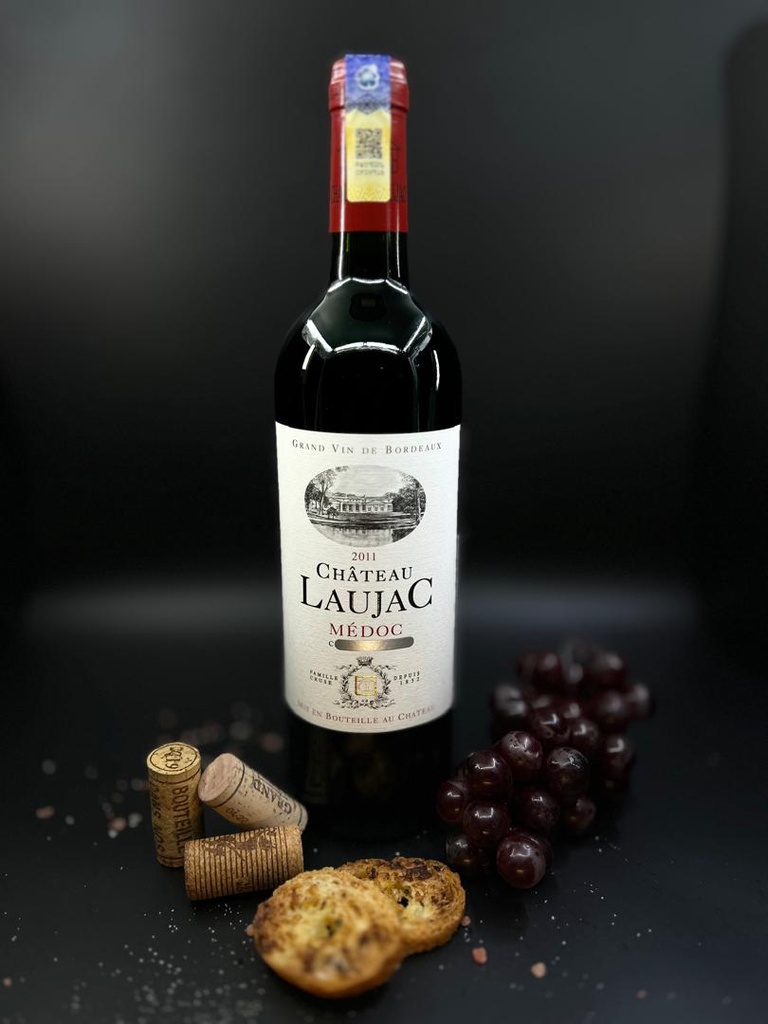2011 Chateau Laffitte laujac
The 2011 Château Laffitte Laujac is a Bordeaux red,
primarily made from Cabernet Sauvignon and Merlot,
offering aromas of black currant, spice, and toast.
It has a medium body, firm tannins, and a long finish.
| Wine Style: Red |
| County: France |
| Grapes Variety: cabernet sauvignon/merlot/petit verdot |
| Tasting: Medium to full-bodied |
The 2011 Château Laffitte Laujac is a red wine from the Bordeaux region in France, specifically from the Haut-Médoc appellation. This wine is a blend of traditional Bordeaux grape varieties, likely including Cabernet Sauvignon, Merlot, and possibly Petit Verdot or Cabernet Franc. Below are detailed information about the wine, as well as recommendations for serving and decanting.
Ingredients and Grape Composition:
- Grape Varieties:
- Cabernet Sauvignon: The dominant grape variety in this wine, contributing structure, tannins, and flavors such as blackcurrant, plum, and tobacco.
- Merlot: This grape adds roundness and softness to the wine, with fruit flavors like red berries and a smooth texture.
- Petit Verdot: Sometimes used in small amounts to add color, depth, and spicy notes.
- Cabernet Sauvignon: 50-60%
- Merlot: 30-40%
- Petit Verdot: 5-10%
Wine Information:
- Region: Bordeaux, Haut-Médoc (AOC)
- Vintage: 2011
- Alcohol Content: Typically around 13-14% ABV, although it can vary slightly.
- Aging: The wine is typically aged in oak barrels (often a mix of new and used barrels) for a period of around 12-18 months, which adds complexity, smoothness, and flavors of vanilla, spice, and toast.
Tasting Notes:
- Appearance: Deep ruby red color with purple hues, indicative of its youth and vibrant fruit.
- Aroma: The nose is complex with aromas of dark fruits like blackberries, plums, and cassis (black currant), along with earthy notes, tobacco, and hints of oak and vanilla.
- Taste: On the palate, the wine is medium to full-bodied, with structured tannins from the Cabernet Sauvignon and the richness of Merlot. You’ll experience flavors of dark fruit (blackcurrant, cherry), earthiness, and a touch of spice, with well-integrated oak flavors adding depth and complexity.
- Mouthfeel: The wine is smooth and balanced, with a good level of acidity and tannins, offering a long, lingering finish.
Food Pairing:
- Red meats: Grilled steak, roast lamb, beef tenderloin, or lamb chops will pair well with the structure and depth of this wine.
- Poultry: Roasted or grilled duck, especially with a rich sauce, works well with the tannins of Bordeaux wines.
- Cheeses: Aged cheeses such as Brie, Camembert, or Gruyère complement the wine’s complex flavor profile.
- Hearty stews: Dishes like beef stew or a lamb tagine, which have a rich and savory flavor, are excellent choices.
Aging Potential:
- The 2011 vintage is likely at a good stage of maturity but can still be cellared for a few more years to develop further complexity. With proper aging, it can reach its peak in 5-10 years after release.
Serving Recommendations:
- Ideal Serving Temperature: The 2011 Château Laffitte Laujac should be served at 16°C to 18°C (60°F to 65°F), which is slightly below room temperature. This temperature allows the wine to fully express its aromas and flavors, while maintaining the right balance between fruit, acidity, and tannin structure.
- Glassware: Use a large Bordeaux glass to allow the wine to breathe and reveal its complexity. Bordeaux glasses have a wider bowl that helps concentrate the aromas, especially in red wines like this one that benefit from oxidation.
Decanting Recommendations:
- Decanting Time: For the 2011 Château Laffitte Laujac, decanting for 30 minutes to 1 hour before serving is recommended. This is especially important for a wine of this age to help it open up and express its secondary and tertiary aromas, such as leather, tobacco, and cedar, while softening any remaining tannins.
- Why Decanting Is Important: Although the 2011 vintage is relatively young and may not have significant sediment, decanting will help to aerate the wine and allow it to evolve in the glass, enhancing its bouquet and texture. The process will help the wine "breathe," releasing more complex aromas and flavors, and will allow the wine to integrate its tannins and acidity better.
- How to Decant: To decant, pour the wine gently into a decanter, avoiding any sediment that may be present. If there is noticeable sediment in the bottle, it is advisable to keep the bottle upright for a day or two before decanting, to allow any sediment to settle.
